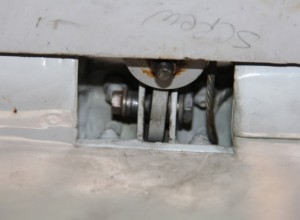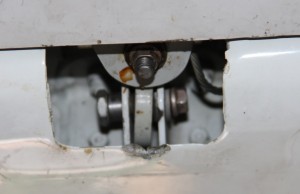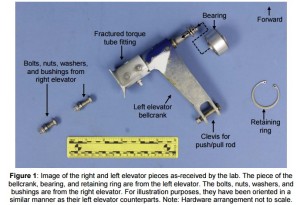Director of Maintenance Pleads Guilty To Obstructing an NTSB Air Accident Investigation
The US Department of Transportation (DOT) Office of the Inspector general (OIG) has released the following statement:
On March 10, 2017, David Esteves of Clearwater, Florida, pleaded guilty in U.S. District Court, Tampa, to obstruction of proceedings before departments, agencies, and committees.
Esteves was the director of maintenance for Avantair, an airline fractional ownership and an on-demand air-charter business located at St. Petersburg-Clearwater International Airport.
Esteves impeded the National Transportation Safety Board (NTSB) and FAA investigation of an accident involving the loss of an elevator from an Avantair aircraft. He instructed a contractor to remove parts from the aircraft and power up the plane, knowing that doing so would erase the cockpit voice recording and thus disrupt the investigation.
While no one else has been charged in this case, federal documents note that Esteves was acting at the suggestion of his superiors at Avantair. Amy Filjones, spokeswoman for the U.S. Attorney’s Office in Tampa, said the federal investigation is ongoing.
Esteves’ lawyer, Scott Robbins, said in court Friday that Esteves was cooperating with authorities. A U.S. magistrate judge did not set a sentencing date for Esteves, who was released on his own recognizance. In court, his lawyer said it was difficult to say whether his client would face prison time.
AINonline report that:
Under the plea agreement, Esteves is subject to a maximum sentence of five years in prison, a fine of $250,000 and three years of probation
The Accident
The accident involved Piaggio P.180 Avanti N146SL and occurred on 28 July 2012 (and is detailed in an NTSB report). The aircraft left Camarillo, CA at 06:15 local time, 23 minutes behind schedule intending to pick up passengers in San Diego, CA and convey them to Henderson, NV. The NTSB state:
During the takeoff roll, the left elevator departed the airplane and was found off the side of the runway [at Camarillo a surprising] 3 days later. The crew arrived at the intermediate airport and quickly boarded the two waiting passengers. They did not perform an adequate preflight inspection and departed about 5 minutes behind schedule. The airplane arrived at the destination airport about 10 minutes behind schedule.
The crew only noticed the left-hand elevator was missing from horizontal stabilizer in Henderson (after 2 sectors).
The NTSB go on:
An examination of the attachment nuts on the hinges of the right elevator found that they were finger tight.
Examination of the hinge fittings on the left elevator and horizontal stabilizer revealed no mechanical damage or deformation to any of the components.
Review of airplane maintenance records showed that an airworthiness directive (AD) had been complied with 54 days earlier, which involved both elevators being removed and then reinstalled. Materials laboratory examination of one of the right elevator attachment hardware bolt-nut combinations revealed that the self-locking nut exhibited run-on torque values well below the acceptable minimum torque.
Based on the finger tight condition of the right elevator attachment hardware and the lack of any mechanical damage to the hinge fittings of the left elevator and stabilizer hinge structure, it is likely that all four sets of attachment hardware for both elevators were not properly torqued during the AD maintenance 54 days earlier.
Additionally, 26 days before the event, a phase inspection was completed during which the elevator should have been visually inspected and functionally checked.
The airplane had flown 158.9 hours with loose elevator attachment hardware before the two sets of bolts on the left elevator had completely worked their way out of the hinges, and the elevator departed the airplane.
The cockpit voice recorder revealed that the flight crew had experienced unusual pitch control responses during each of the departures and landings. The flight crew could have identified the missing elevator during a preflight inspection at the intermediate airport, yet they decided to continue the flight despite the pitch control problems experienced during the takeoffs and landing.
The NTSB determined the probable cause as:
The failure of maintenance personnel to properly torque the elevator attachment hardware in accordance with the maintenance manual, which led to the detachment of the elevator.
There is no examination of the circumstances of that failure two months earlier. The NTSB go on:
Contributing to the accident were maintenance personnel’s failure to identify the loose attachment hardware during a scheduled inspection, the flight crew’s decision to continue the flight after identifying a flight control problem, and the flight crew’s failure to perform an adequate preflight inspection at the intermediate airport.
For more background on critical maintenance tasks see:
- Critical Maintenance Tasks
- Fatal $16 Million Maintenance Errors
- Misassembled Anti-Torque Pedals Cause EC135 Accident
- EC130B4 Accident: Incorrect TRDS Bearing Installation
- Loose B-Nut: Accident During Helicopter Maintenance Check Flight
- USAF RC-135V Rivet Joint Oxygen Fire
- UPDATE 26 March 2017: Cessna 208 Forced Landing: Engine Failure Due To Re-Assembly Error
The Attempted Cover Up
However, buried in the NTSB Public Docket for this accident is the statement to the NTSB of a contracted mechanic at Henderson, who had been involved immediately after the damage was found, of events two days later:
On Monday [July, 30th]…I was awakened by a phone call from Mr. Esteves at 06:55L Mr. Esteves asked me to remove the RH Elevator and immediately ship the bolts to his attention at their address in Clearwater, FL. Mr. Esteves also asked me to apply power to the aircraft for 30-45 minutes. In addition to the request to remove the Elevator and apply power, he instructed me to inform anyone asking, that the hardware had already been shipped.
We quickly dispatched to the aircraft at 07:20L and removed the RH Elevator. We did not power up or apply external power to the aircraft. We were under the impression that Avantair was working in coordination with their FSDO in Florida, and were requesting the bolts to investigate a material failure. Having provided them, previously, with detailed pictures, we assumed, that all investigating parties (Avantair, FAA, Piaggio America) were informed of the loose hardware we had found on the existing RH Elevator on Saturday.
It wasn’t until later, Monday morning, that I received a call from the V.P. of Maintenance at Avantair, Mr. <<name in public docket>>, telling me that I was not contracted by Avantair to perform any form of investigation, nor was I to provide my opinion of the hardware or it’s loose installation to anyone, as it would complicate the ongoing investigation currently underway in FL and NV. I then departed the aircraft at approximately 10:15L.
At 1535L, on Monday, I received my last call from Dave Esteves. In this phone call he informed me that the NTSB Investigator had called him, and was requesting that the Cockpit Voice Recorder be removed from N146SL. He again asked me if I had been able to put external power on the aircraft.
Confused by his request, I told him we had not, and asked why we needed to run external power for 30-45 minutes. He then told me it would erase the CVR. I again asked him to clarify, “you want me to wipe the CVR?”, and he replied “Yes”. I told him, I am unwilling to comply…
Esteves own interview with investigators is also in the public docket.
The CVR Recording
The NTSB report that:
The airplane was equipped with an L-3/Fairchild FA2100-1010 cockpit voice recorder (CVR), which records 30 minutes of digital audio stored in solid-state memory modules. The CVR was removed, and sent to the NTSB’s Audio Laboratory for readout. The CVR contained 30 minutes of excellent quality recording from the captain’s and first officer’s audio panels, and 30 minutes of good quality recording from the cockpit area microphone (CAM). After the airplane engines were shut down and the passengers disembarked, the CAM recorded a 2 1/2-minute cell phone call made by the Captain. The Captain described to the person on the other end of the phone that he and the First Officer were not getting normal elevator control at rotation and landing, and that he had no real control during the landing flare. He described the takeoff out of San Diego where he had the control yoke all the way back at rotation speed of 106 kts, but the airplane didn’t rotate until 120 kts. On the departure out of Camarillo the First Officer said the controls felt strange, and he saw him pull the yoke all the way back. The Captain also said that at that point they were in a hurry, and that was why he hadn’t called in the problem after departing Camarillo.
The Airworthiness Aftermath and Bankruptcy
After the accident the NTSB say:
On August 7, 2012, Avantair initiated a fleet wide inspection of all their Piggio P180 airplanes. The focus of the action was to inspect and replace as necessary all elevator mounting hardware. The Executive Vice President of Avantair confirmed on December 6, 2012, that as a precaution, all elevator self-locking nuts had been replaced with new hardware for their fleet of P180’s.
The knock on effect of that disruption was one factor that drove Avantair into bankruptcy a year later. As BCA report, a:
…second voluntary grounding occurred this June [2013], ostensibly over discrepancies in life-limited parts tracking. While the parts — as many as 100 per aircraft — were claimed by the company as not critical to safety of flight, Avantair nevertheless chose to voluntarily park the fleet until it could ensure the parts were in compliance with FAA-mandated life limits. Subsequent FAA inspections of Avantair aircraft in July and August revealed the “unairworthiness of a sizeable sample” of the Avantair fleet, including missing engines and propellers and dozens of other discrepancies in documentation, missing components, loose panels and other issues. As a result, the agency pulled the airworthiness certificates of all the P180s in the Avantair fleet… On June 26, it informed the Security and Exchange Commission that it had begun to furlough employees “as the company addresses liquidity issues and seeks alternative financing arrangements.” Bankruptcy Judge Catherine Peek McEwen ordered the liquidation on Aug. 16.
Owners scrambled to find their planes. Nine were found in a hangar Avantair rented at Dallas Love Field in Texas. According to owners, Avantair had cannibalized a good portion of them to keep other planes running. Engines were missing, and there was no record of how the planes had even ended up there.

Piaggio P-180 Avanti in-flight demonstration at Rennes AirShow 2010 – Note this is not an Avantair aircraft (Credit: Tibboh)
UPDATE 1 May 2017: In a different case: U.S. pilot sentenced to 10 months for operating aircraft without license
UPDATE 23 June 2017: Esteves has been sentenced to eight months of house arrest, three years of probation and a $2,000 fine for obstructing the NTSB and FAA.
Safety Resources
- UPDATE 8 June 2020: Fatal Falcon 50 Accident: Unairworthy with Unqualified Crew
Aerossurance is pleased to sponsor the 2017 European Society of Air Safety Investigators (ESASI) 8th Regional Seminar in Ljubljana, Slovenia on 19 and 20 April 2017. Registration is just €100 per delegate. To register for the seminar please follow this link. ESASI is the European chapter of the International Society of Air Safety Investigators (ISASI).







Recent Comments